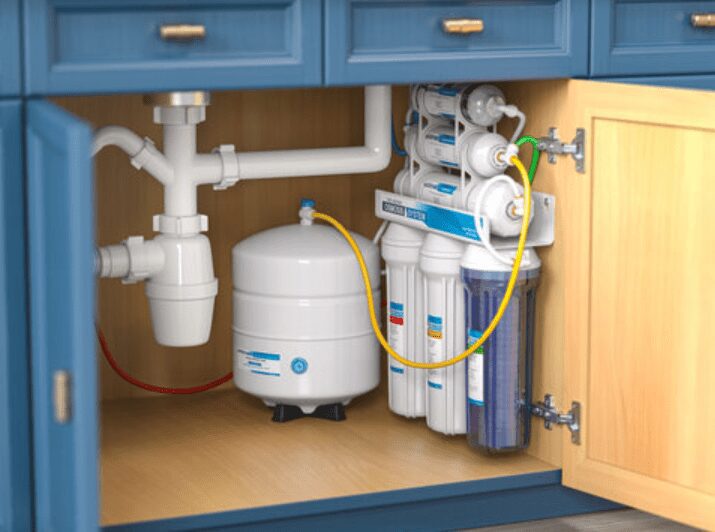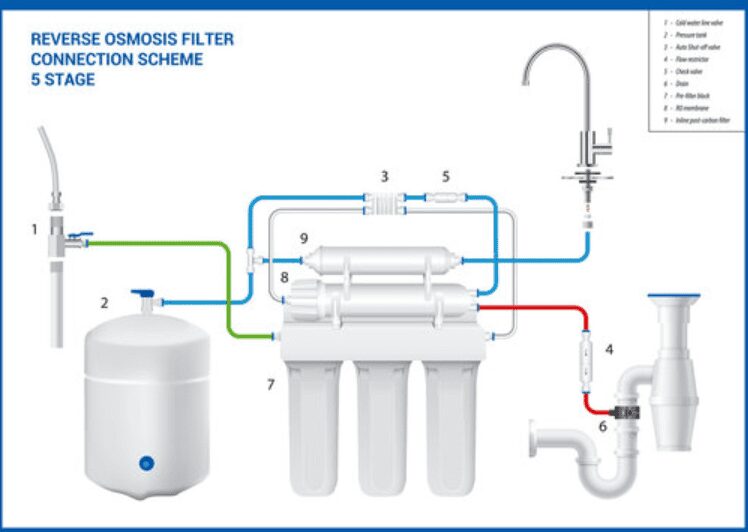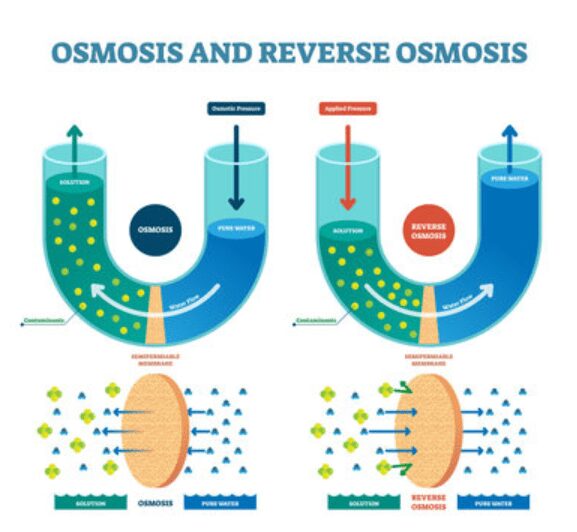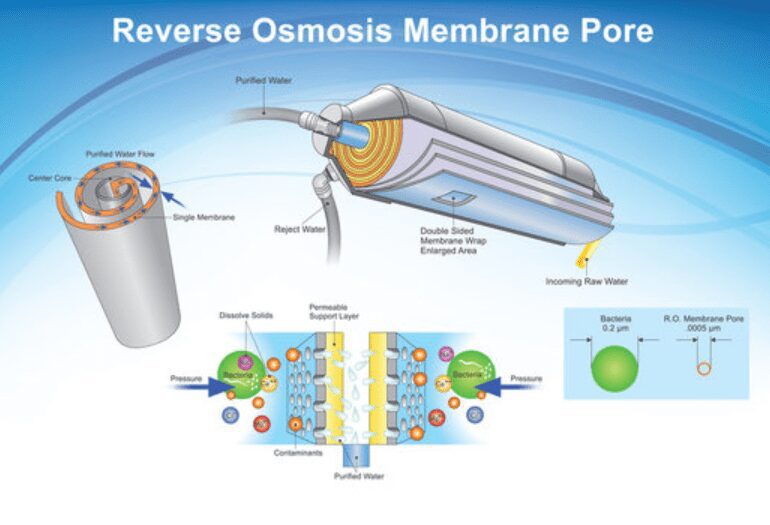
Reverse osmosis (RO) is a popular water purification method that uses a semipermeable membrane to separate impurities and contaminants from water. Applying pressure forces water through the membrane, leaving behind unwanted particles and producing clean, filtered water.
Understanding the Reverse Osmosis Process
The Components of an RO System

- A reverse osmosis system consists of several essential components that efficiently purify water.
Cold water line valve
This valve connects the system to your home’s cold water supply, allowing water to flow into the reverse osmosis unit.
Pre-filters
Pre-filters remove larger particles from the water, such as sediment, sand, and rust. This step protects the reverse osmosis membrane from damage and clogging. Common types of pre-filters include sediment filters and carbon filters.
Reverse osmosis membrane
The system’s heart, the reverse osmosis membrane, is a semipermeable membrane that effectively removes many contaminants, including heavy metals, salts, bacteria, and viruses. Only water molecules can pass through the membrane, while impurities are left behind.
Flow restrictor
This component regulates water flow through the system, ensuring the reverse osmosis process operates at the optimal pressure.
Post-filters
After passing through the reverse osmosis membrane, the water may go through post-filters, typically carbon filters, to improve taste and remove any remaining impurities.
Storage tank
The purified water is stored in a tank until needed. This tank is pressurized to ensure a steady water flow when you turn on the faucet.
Faucet
A dedicated faucet dispenses the purified water from your regular kitchen faucet. This faucet is connected to the storage tank and often has an air gap to prevent backflow.
Drain line
The drain line carries the wastewater to your home’s drain system, containing the contaminants removed from the water. This wastewater is also known as “brine” or “concentrate.”
Check valves and shut off valves.
These valves control the water flow within the system, preventing backflow and ensuring that the system operates correctly.
These essential components work together in a reverse osmosis system to provide clean, purified water for you and your family.
How are Reverse Osmosis Systems Different from a Water Filters?
Reverse osmosis systems and water filters both aim to provide clean and safe drinking water, but they differ in their methods, filtration capabilities, and complexity. Here are some key distinctions between the two:
- Filtration method: A reverse osmosis system uses a semipermeable membrane and pressure to force water through the membrane, trapping contaminants on one side and allowing purified water to pass through. In contrast, a water filter typically uses an activated carbon filter or other filtration media to trap and remove contaminants as water passes through.
- Contaminant removal: Reverse osmosis systems are highly effective at removing a wide range of contaminants, including heavy metals, salts, bacteria, viruses, and many chemicals. Water filters, especially those using activated carbon, can effectively remove chlorine, sediment, and some chemicals, but may not be as efficient at removing heavy metals, bacteria, and viruses.
- Complexity: A reverse osmosis system generally consists of multiple filtration stages, a storage tank, and a dedicated faucet. It may require professional installation and regular maintenance to replace filters and the RO membrane. On the other hand, water filters can range from simple faucet-mounted or pitcher filters to more complex under-sink or whole-house systems. These filters usually require less maintenance than reverse osmosis systems, with filter replacements needed less frequently.
- Water waste: Reverse osmosis systems produce wastewater as part of the filtration process, where some water is discarded along with the contaminants. The amount of water wasted depends on the system’s efficiency. Water filters, in general, do not produce wastewater, making them more water-efficient.
- Mineral content: Reverse osmosis systems can remove beneficial minerals from the water, potentially altering the taste and reducing the water’s nutritional value. Some water filters, particularly those using activated carbon, retain these minerals, maintaining the water’s natural taste and mineral content.
In summary, reverse osmosis systems and water filters differ in their filtration methods, contaminant removal capabilities, complexity, water waste, and impact on the water’s mineral content.
While reverse osmosis systems provide a higher level of purification, water filters can be a more straightforward and water-efficient option for removing common contaminants. The two choices depend on your specific water quality concerns and preferences.
Does RO Impact Water Pressure?
Yes, a reverse osmosis (RO) system can impact water pressure in two primary ways:
1. Inlet water pressure
An effective RO system requires a minimum water pressure at the inlet, typically around 40-60 psi (pounds per square inch). Suppose the incoming water pressure is too low.
In that case, the system may not push water through the semipermeable membrane efficiently, leading to reduced filtration performance and a slower flow rate.
In such cases, a booster pump can be added to the system to increase the water pressure and improve the system’s performance.
2. Faucet water pressure
The water pressure at the dedicated RO faucet can be lower than your normal tap water pressure. This decrease in pressure is due to the filtration process and the storage tank.
Water passes through the RO membrane and is filtered slower than it would flow through a standard water filter or directly from your tap.
The pressurized storage tank may not provide the same pressure level as your regular water supply. As a result, you may notice a reduced flow rate when dispensing water from the RO faucet.
The Stages of Reverse Osmosis
A reverse osmosis system uses a semipermeable membrane to purify water by removing contaminants, impurities, and unwanted particles. The process involves several key steps:
- Pre-filtration: The water first passes through a pre-filter, which removes larger particles like sediment, sand, and rust. This step helps protect the delicate reverse osmosis membrane from damage and clogging.
- Carbon filtration: Next, the water flows through a carbon filter, which removes chlorine and other chemicals that can affect the taste and odor of the water. This step also helps protect the RO membrane from damage.
- Reverse osmosis process: The system’s heart is the reverse osmosis membrane, designed to remove a wide range of contaminants, including heavy metals, salts, bacteria, and viruses. Water is forced through the semipermeable membrane under pressure, allowing only water molecules to pass through while trapping the contaminants on the other side.
- Post-filtration: After passing through the RO membrane, the water may go through a post-filter, usually a carbon filter, to further improve the taste and remove any remaining impurities.
- Storage and delivery: The purified water is then stored in a tank until needed. When you turn on the faucet, the water passes through a final polishing filter before reaching your glass, ensuring it’s clean and delicious.
Weighing the Pros and Cons: Benefits and Drawbacks of Reverse Osmosis Systems

The Bright Side: Advantages
- Top-notch water quality: The reverse osmosis system effectively removes contaminants, including heavy metals, bacteria, viruses, and other impurities, providing safe and great-tasting water.
- Cost-effective: A reverse osmosis system is more cost-efficient and eco-friendly than bottled water.
- Low maintenance: These systems are relatively simple, requiring only periodic filter replacements and occasional cleaning.
The Flip Side: Disadvantages
- Water Waste: A reverse osmosis system can waste significant water during the purification process, depending on the model and efficiency.
- Slow filtration rate: The process may be slower than other methods, potentially leading to a reduced flow rate at the faucet.
- Removal of beneficial minerals: Some reverse osmosis systems may strip the water of essential minerals, which could impact the taste and nutritional value.
Shopping Around: How to Choose the Right Reverse Osmosis System for You
Selecting the ideal reverse osmosis (RO) system for your needs can be overwhelming due to the numerous options available. To make the process easier, consider the following factors when choosing the right RO system for your home or business.
Assess Your Water Quality
Before purchasing an RO system, you must test your water quality to determine the contaminants present. Some common impurities include heavy metals, chemicals, and microorganisms.
By understanding your water’s composition, you can select an RO system with the appropriate filtration stages to address your specific concerns.
Determine Your Water Usage
To choose an RO system with the correct output capacity, estimate your daily water consumption. A typical household system produces 50-100 gallons of purified water daily, but larger units are available for commercial applications.
Be sure to consider the water pressure and recovery rate, which impact the system’s efficiency and output.
Evaluate Installation and Space Requirements
Evaluate the available space under your sink or in the designated installation area. Most RO systems are compact and designed for under-sink installation.
However, consider a countertop or portable RO system if space is limited. Additionally, ensure you have access to a nearby water supply and a drain for wastewater disposal.
Consider Maintenance and Filter Replacement Costs
Proper maintenance is crucial for the performance and longevity of your RO system. Factor in the costs of replacing pre-filters, post-filters, and the RO membrane. These expenses will vary based on the system’s specific requirements and your water usage.
Compare Additional Features and Certifications
Some RO systems offer additional features like UV sterilization, remineralization, or smart monitoring capabilities. Evaluate these options to determine if they align with your needs and preferences.
Additionally, check for certifications from NSF International or the Water Quality Association. These certifications ensure the system meets strict industry standards for contaminant removal and performance.
Budget Considerations
RO systems are available at various prices, from budget-friendly options to premium models with advanced features. Determine your budget and weigh the benefits of each system within your price range to find the right balance between cost and performance.
Considering these factors, you can confidently choose the right reverse osmosis system. A high-quality RO system will provide clean, safe, and great-tasting water, contributing to a healthier lifestyle and long-term cost savings.
Popular Reverse Osmosis System Models
Some popular reverse osmosis system models on the market include:
10 Best-Selling Reverse Osmosis System Models On Amazon
Superior Water Quality
RO systems remove up to 99% of contaminants, including:
- Heavy metals (e.g., lead, mercury, arsenic)
- Chemicals (e.g., chlorine, fluoride)
- Bacteria and viruses
- Dissolved salts
Eco-friendly
RO systems are more environmentally friendly than bottled water, reducing plastic waste and carbon emissions.
Cost-effective
Although the initial investment in an RO system can be substantial, it provides long-term cost savings by reducing the need to purchase bottled water.
Will reverse osmosis remove minerals that are healthy for my body?
Yes, reverse osmosis can remove minerals that are healthy for your body, such as calcium, magnesium, and potassium. While these minerals are not essential to consume through water, as a balanced diet typically provides the necessary intake, some people might prefer water that retains these beneficial minerals.
To address this concern, consider installing a remineralization filter as part of your reverse osmosis system. After purification, this filter adds essential minerals, ensuring that your water remains clean and nutritious.
The process involves applying pressure to push water through the membrane, separating it from the pollutants and leaving you with crystal-clear, delicious drinking water.
1.2 The Science Behind the Process
Reverse osmosis takes advantage of the natural process of osmosis, which involves the movement of water molecules through a semipermeable membrane from a region of low solute concentration to one of high solute concentration.
By applying pressure to the more concentrated side, reverse osmosis forces the water molecules to move in the opposite direction, leaving the impurities behind.

Maintaining Your Reverse Osmosis System
Proper maintenance is essential for the longevity and performance of your RO system. Here are some tips for keeping it in top condition:
- Replace pre-filters and post-filters regularly: These filters should be replaced every 6-12 months, depending on the water quality and usage.
- Change the RO membrane: The membrane typically lasts 2-3 years, but monitoring water quality and changing it as needed is essential.
- Clean and sanitize the system: Perform an annual cleaning and sanitization to prevent bacterial growth and ensure optimal performance.
- Inspect the storage tank: Check its air pressure and adjust it to maintain efficient operation.
Final Thoughts on Reverse Osmosis
In conclusion, reverse osmosis water filtration systems have become an essential solution for providing clean and safe water in various applications, from residential to commercial and even military use.
The process involves utilizing a semi-permeable membrane, high-pressure pumps, and multiple stages of filtration to remove impurities, such as salts, ions, and contaminants, from the feed water.
While the energy required for reverse osmosis can be significant, advancements in membrane technology and energy-efficient designs have made these systems more cost-effective and sustainable in recent years.
It’s crucial to consider factors such as water quality, usage, space requirements, maintenance, and budget when selecting the most suitable reverse osmosis system for your needs.
Investing in a high-quality RO system ensures a reliable supply of desalinated, pure, and fresh water, minimizing the risk of health issues associated with contaminated water sources.
Additionally, proper pretreatment, scale inhibitors, and post-treatment measures can prevent fouling and prolong the lifespan of your RO membranes, ensuring optimal performance and efficiency.
In today’s world, where water scarcity and pollution are pressing concerns, reverse osmosis water filtration systems have emerged as a critical tool in addressing these challenges.
By understanding the underlying principles and benefits of RO technology, you can make an informed choice and contribute to a healthier and more sustainable future for all.
Last update on 2024-11-12 / Affiliate links / Images from Amazon Product Advertising API




































